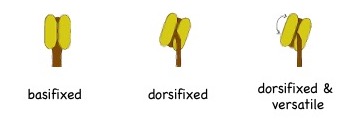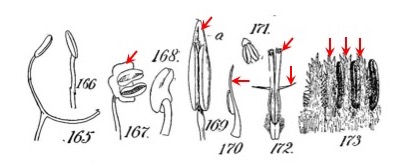The androecium
The "androecium" refers to all of the stamens in a flower.
A stamen consists of an anther and a filament. The anther has one, two, or four pollen sacs, each containing pollen. The stalk of the anther is the filament. Sterile (nonreproductive) tissue between pollen sacs (an extension of the filament) is called the connective.
Anthers may be connected to the filament at their base (called "basifixed" anthers in most texts) or at their backs (called "dorsifixed" anthers in many texts). In some cases, anthers attached to a filament at their backs can swing freely on their filaments, and are called versatile anthers.

Anther sacs may dehisce by pores, by longitudinal slits, by transverse slits, or by valves to release pollen grains.

Stamens may have appendages in various locations, and their connective may take on different shapes. Examples are shown below.

Some flowers have one or more staminodes (sterile stamens or stamens without functional anthers).